|
| |
|
Bhujangasana (Serpent
posture) |
|
*Sthiti: Lie prone on the blanket, keeping the legs
together, chin touching the ground, and the soles facing up. Stretch the
hands straight forward alongside the head resting the palms on the
ground.
|
-
Bring the arms back to the
level for the last rib bone. Keep the hands bent at elbows; least
pressure to be exerted on the hands. Maintain the elbows touching the
body; let in not spread out.
-
Raise the head first and then
the upper portion of the trunk slowly, just as the cobra raises its
hood, till the navel portion is about to leave the ground. Arch the
boreal spine well. Keep the body below navel straight in tough with the
ground. |
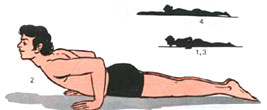 |
|
BENEFITS:Helps
in keeping the dorsal spine elastic and strong. Backache due to overstrain
can be relieved. Helps in considerable reduction of the abdominal fat.
Useful Asana for Bronchitis, Asthma and Cervical
spondylosis.
|
|
Salabhasana (Locust
Posture) |
|
*Start with Sthiti. |
|
-
From a first with the thumb
inside and place it under the abdomen.
-
Inhale and hold the breath.
Rise the legs up together from the waist without bending the knees.
*Maintain for some time. Slowly being down the legs with
exhalation.
|
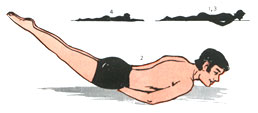 |
|
BENEFITS: Relieves
constipation and tones up the kidneys. Muscles of the hips and the lumbar
region and toned up
|
|
Dhanurasana (Bow
Posture) |
|
*Come to Sthiti
position. |
|
-
Bend the knees and hold the
feet by the hands.
-
Raise the hand, chest and also
thighs by tugging the hands and legs, so that the spine is arched
backwards like a bow. Stabilize (Rest) on the abdomen. Elbows must be
kept unbent. Look up. Initially the knees will spread out, but with
practice they can be brought very near, almost touching each other.
Maintain for about half a minute. Normal breathing.
*Slowly come down
through 3 to 4.
BENEFITS: Removes
gastro-intestinal disorders. Digestion improves. Helps in slimming the
body and abdomen. A good stimulating posture for the back
limbs.
|
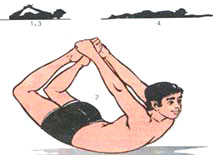 |
|
Makarasana (Crocodile
Posture) |
|
*Come to Sthiti
position. |
|
-
Widen the feet; heels inwards
touching the ground; fingers out wards.
-
Bending the right hand, place
the right palm on the left shoulder. Keep the left palm on the right
shoulder, the chin in front of the hands such that the neck is supported
at the point where the two arms cross. Rest and relax in this position.
*Come back through 3 to 4. |
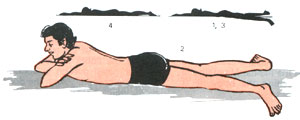 |
|
BENEFITS: This relaxation
posture is useful for many ailments caused by tensions like high B. P.,
insomnia etc. |
|
Sarvangasana (Stand-on-Shoulder
Posture) |
|
*Sthiti: Lie
supine on the ground over a blanket, keeping the arms stretched above the
head.
-
Raise
the legs together very slowly and gracefully (without bending at the
knees) till it forms about 45 degrees to the ground.
-
Raise
the legs further to 90 degrees.
-
Now
raise the buttocks and the trunk also, taking support of the arms and
the elbows, without lifting the hand. Rest the elbows on the ground
firmly and support the back with both the palms. Straighten the trunk
with the hands till the chin is well set in the suprasternal hollow.
Bring the legs parallel to the ground.
-
Keep
the body, erect stretching it up vertically supporting on the shoulders
but relaxingly. Maintain for about 2 minutes. Carefully avoid all jerks
and keep the head on the ground.
*Slowly come back to Sthiti
thorough 5 to 8.
BENEFITS: Maintains the
thyroid healthy which in turn keeps the body active and healthy.
Beneficially influences the Pelvic organs, both active and healthy.
Beneficially influences the various veins, piles, hernia and menstrual
disorders. Persons with cervical spondylosis should not do this
asana.
|
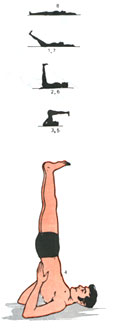
|
|
The
final position can be reached in two ways either starting from the sitting
position or from lying down position.
A.
Sthiti: Sit on the blanket with legs stretched
out. |
-
Bend the right leg and place
it on the left thigh.
-
Place the left leg on the
right thigh thus assuming Padmasana.
-
Bend backwards; support the
body first by the right elbow and then the left elbow and rest the head
on the ground. Place the palms above the shoulders, the shoulders on
either side of the head, fingers pointing to the shoulders.
-
Taking the weight on the
palms, lift the head and chest off the ground. Bring the centre of the
crown of the head to the ground by bending the dorsal and cervical spine
backwards. Remove the hands after the weight is balanced on the head.
Catch hold of the big toes by hooking the index fingers around them.
Maintain about 1/3 the time of maintenance of Sarvangasana about ½
meter.
*Return to Sthiti through 5 to 8. |
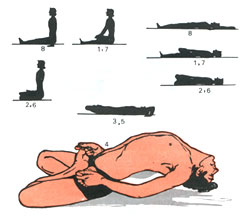 |
|
B. Sthiti: Lie
supine on the blanket with hands stretched above the
head. |
-
Take the right leg and place
it on the left thigh.
-
Place the left leg over the
right leg on the right thigh. Take the hands on either side of the
head.
*Other numbers 3, 4, 5 and 6 are same. Counts 7 and 8
correspond to 1 and Sthiti of the lying-down position.
*Matsyasana is
a complementary asana to Sarvangasana and is normally maintained for
about 1/3 the duration of Sarvangasana. |
|
BENEFITS: The
benefits of Sarvanganasana are enhanced when it is followed by Matsyasana.
Specially good for Diabetes, Asthma patients and people threatened with
other lung diseases. |
|
Halasana (Plough
Posture) |
|
*Steps are the same as in
Sarvangasana except the final position 4 where the legs are stretched
further to tough the ground.
BENEFITS: The muscles of the back, the spinal joints
and the lumbar nerves are fully stretched, thus promoting their health.
Neck region receives plenty of blood supply and the nerves are toned up.
Also contributes to the health of the thyroid glands. Spine becomes
elastic. |
 |
|
Cakrasana (Wheel
Posture) |
|
*Sthiti: Lie supine on the ground with legs
together and arms along with the body. |
|
-
Take the hands back; place the
palms on the ground and above the shoulders on either side of the head.
The fingers face the shoulders. Bend the knees and fold the
legs.
-
With palms and soles as 4
points of support, raise the trunk making an arch convex upwards to look
like a wheel.
*Return to Sthiti
slowly.
BENEFITS: Builds a flexible back.
Stimulates the nerves of the spine; one of the powerful back-bending
postures.
|
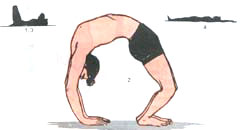 |
|
Sirsasana (Stand-on-Hand
Posture) |
|
*Sthiti:
Place a fourfold blanket on the ground and sit on the knees.
-
Interlock the fingers, make a
convenient angle (say 60 degrees) with your forearms, forming an
equilateral triangle on the ground. Place the centre of the head (Vide
note) on the blanket in between the fingers locks. Support the back of
the head by the interlocked fingers.
-
Now raise the knees, keeping
the toes on the ground. Bring the thighs near the chest and when it
touches the chest, lift the toes off the ground slowly. Bring the trunk
perpendicular to the flood, Fold the leg so that the feet touch the
buttocks.
-
Raise the bent knees up, till
the thigh come parallel to the ground.
-
Now straighten the legs, so
that the body stands perpendicular to the ground. Maintain the posture
for a minute in a very relaxed way; normal breathing.
*Return to
Sthiti through 5 to 8. |
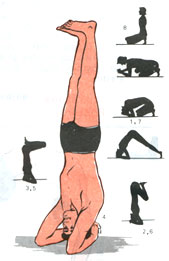 |
|
BENEFITS: Due
to improved circulation to the brain the whole nervous system becomes
healthy. Memory power gets improved. Endocrine glands such as the
pituitary, and the thyroid get revitalized. Helpful in hernia. Seminar
weakness can be cured. Improves concentration power
remarkably.
Caution: Those having
running ears, heart trouble, high blood pressure and weak eye capillaries
should not practice Sirsasana.
Note:
Some 'School of Yoga' are of the opinion that the front part of the head
is preferable. |
|
*Sthiti: Lie
supine on the ground with hands and feet apart. |
|
-
Slightly stretch the body and
allow the whole body to relax completely.
-
By concentrating the mind on
different parts of the body starting from the toes and the head, a
feeling of relaxation is propagated. This auto-suggestion can be learnt
or the teacher who gives the instruction. Gradually one learns to
suggest oneself to relax part by part. |
 |
*As one gets the control, the art of relaxation will be natural and
spontaneous. Then the whole body is relaxed to the extent one forgets
the body and the mind experiences alterful
rest.
BENEFITS: One of the most powerful tools
in controlling large number of diseases caused by tension such as high
B.P., Insomnia etc. It is very helpful for calming down the mind leading
to meditation. |
|
A. Type
1
Sthit: Lie supine on the ground over the
blanket, heels together, arms stretched above the head .
- Raise the right leg
keeping it straight to about 45 degrees from the ground. Keep the left
leg firmly on the ground. Inhale partially.
- Place the right led
perpendicular to the founds; complete inhalation.
- Bend the right leg
and press the knees over the chest by holding the legs by interlocked
fingers of the head. Exhale. Continue the movement keeping the knee
straight and bring the leg perpendicular to the ground.
|
 |
-
Take
the chin above the knees. Rotate the left leg in an elliptical fashion 5
times in the clockwise direction and 5 times in the anti-clockwise
direction. Normally breathing * Returns to Sthiti position through 5 to
8. * Repeat with the left leg. |
|
|
|
B. Type
2
Start from Sthiti position.
- Take both legs
to 45 degree position; keep the knees straight. Inhale
slowly.
- Bring the legs
perpendicular to ground; complete inhalation.
- Bend the
knees, press them on the chest by the hands with interlocked
fingers. Exhale.
- (a) Roll the
body to the right until the right elbow touches the ground. Roll
back to the left till the left elbow touches the ground. Repeat
this sideward rolling 5 times. (b) Rock the body forwards and
backwards about 5 times; normal breathing. *Return to 'Sthiti'
through 5 to 8.
|
 |
|
BENEFITS:
The movements coupled with the posture of the body in Pavana
Muktasana help to remove the gaseous accumulations in the stomach,
increases digestive power and removes the
constipation.
| |
Disclaimer and terms of use
Copyright © Shanith Babu Nagarajan. All rights reserved.
|